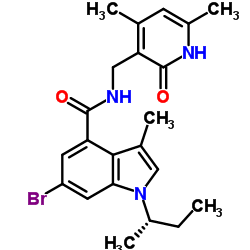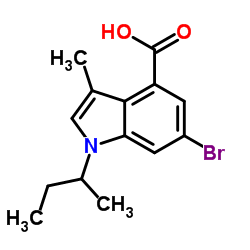GSK126

GSK126 structure
|
Common Name | GSK126 | ||
|---|---|---|---|---|
| CAS Number | 1346574-57-9 | Molecular Weight | 526.672 | |
| Density | 1.3±0.1 g/cm3 | Boiling Point | 823.4±65.0 °C at 760 mmHg | |
| Molecular Formula | C31H38N6O2 | Melting Point | N/A | |
| MSDS | N/A | Flash Point | 451.8±34.3 °C | |
Use of GSK126GSK126 is a potent, highly selective inhibitor of EZH2 methyltransferase with an IC50 of 9.9 nM. |
| Name | 1-[(2S)-butan-2-yl]-N-[(4,6-dimethyl-2-oxo-1H-pyridin-3-yl)methyl]-3-methyl-6-(6-piperazin-1-ylpyridin-3-yl)indole-4-carboxamide |
|---|---|
| Synonym | More Synonyms |
| Description | GSK126 is a potent, highly selective inhibitor of EZH2 methyltransferase with an IC50 of 9.9 nM. |
|---|---|
| Related Catalog | |
| Target |
EZH2:9.9 nM (IC50) |
| In Vitro | GSK126 potently inhibits both wild-type and mutant EZH2 methyltransferase activity with similar potencies (Ki=0.5-3 nM) independent of substrate used, and is competitive with S-adenosyl-methionine (SAM) and non-competitive with peptide substrates. GSK126 is highly selective against other methyltransferases and multiple other protein classes (EZH1, IC50=680 nM)[1]. Treatment of three SCLC cell lines with GSK126, induces growth inhibition. SCLC cell lines (Lu130, H209, and DMS53) are treated with 0.5, 2, and 8 μM GSK126, and growth curve is analyzed by WST-8 assay. Inhibition of cellular growth by GSK126 treatment is observed at 8 μM in all the three cell lines, while Lu130 and H209 are more sensitive to GSK126, even at lower doses[2]. |
| In Vivo | GSK126 is administered intraperitoneally at a dose volume of 0.2 mL per 20 g body weight in female beige SCID mice. GSK126 effectively inhibits the proliferation of EZH2 mutant DLBCL cell lines and markedly inhibits the growth of EZH2 mutant DLBCL xenografts in mice[1]. |
| Kinase Assay | The five-member PRC2 complex (Flag-EZH2, EED, SUZ12, AEBP2, RbAp48) containing either wild-type or mutant (A677G, Y641N, Y641C, Y641H, Y641S or Y641F) EZH2 is prepared. GSK126 is dissolved in DMSO and tested at concentrations of 0.6 nM to 300 nM with a final DMSO concentration of 2.5%. In contrast to wild-type EZH2 which prefers H3K27me0 as a substrate in vitro, EZH2 Y641 mutants prefer H3K27me2 and have little activity with H3K27me0 or H3K27me1. The A677G mutant is distinct from both the wild-type and Y641 mutant forms of EZH2 in that it efficiently methylates H3K27me0, H3K27me1, and H3K27me2; therefore, histone H3 peptides (residues 21-44; 10 μM final) with either K27me0 (wild type, A677G EZH2), K27me1 (A677G EZH2), or K27me2 (A677G, Y641N, Y641C, Y641H, Y641S and Y641F EZH2) are used as methyltransferase substrates. GSK126 is added to plates followed by addition of 6 nM EZH2 complex and peptide. As the potency of GSK126 is at or near the tight binding limit of an assay run at [SAM]=Km, IC50 values are measured at a high concentration of the competitive substrate SAM relative to its Km (7.5 μM SAM where the SAM Km is 0.3 μM)[1]. |
| Cell Assay | JUB- and PTRF-introduced DMS53 cells are seeded at density of 1×103 cells/well in 96-well plate, and cellular growth is analyzed using WST-8 kit at 12, 36, 60, and 84 h. Cellular growth of Lu130, H209, and DMS53 with treatment by DZNep or GSK126 is also analyzed using WST-8 kit. DZNep is dissolved in PBS at 5 mM, and cells are cultured at the final concentration of 5 μM. GSK126 is dissolved in DMSO at 10 mM, and cells are cultured at 0.5, 2, and 8 μM[2]. |
| Animal Admin | Mice[1] GSK126 or vehicle is administered intraperitoneally at a dose volume of 0.2 mL per 20 g body weight. Pfeiffer or KARPAS-422 cells (1×107) in 100% Matrigel are implanted subcutaneously in female beige SCID mice. Tumors are measured with calipers, and block randomized according to tumour size into treatment groups. For efficacy studies, 10 mice are randomized in each treatment group before the initiation of dosing and GSK126 treatment is initiated once the tumour volumes are approximately 200 mm3 in the Pfeiffer and KARPAS-422 studies and 500 mm3 in the KARPAS-422 intermittent dosing study. Mice are weighed and tumors measured with calipers twice weekly. Two-tailed t-tests are conducted assuming two samples of equal variance. |
| References |
| Density | 1.3±0.1 g/cm3 |
|---|---|
| Boiling Point | 823.4±65.0 °C at 760 mmHg |
| Molecular Formula | C31H38N6O2 |
| Molecular Weight | 526.672 |
| Flash Point | 451.8±34.3 °C |
| Exact Mass | 526.305603 |
| PSA | 98.80000 |
| LogP | 3.14 |
| Vapour Pressure | 0.0±3.0 mmHg at 25°C |
| Index of Refraction | 1.654 |
| Hazard Codes | Xi |
|---|
|
~% 
GSK126 CAS#:1346574-57-9 |
| Literature: WO2011/140324 A1, ; Page/Page column 83-84 ; WO 2011/140324 A1 |
|
~% 
GSK126 CAS#:1346574-57-9 |
| Literature: WO2011/140324 A1, ; WO 2011/140324 A1 |
|
~% 
GSK126 CAS#:1346574-57-9 |
| Literature: WO2011/140324 A1, ; WO 2011/140324 A1 |
|
~% 
GSK126 CAS#:1346574-57-9 |
| Literature: WO2011/140324 A1, ; WO 2011/140324 A1 |
| N-[(4,6-dimethyl-2-oxo-1,2-dihydro-3-pyridinyl)methyl]-3-methyl-1-[(1S)-1-methylpropyl]-6-[6-(1-piperazinyl)-3-pyridinyl]-1H-indole-4-carboxamide |
| CS-1401 |
| 1-[(2S)-2-Butanyl]-N-[(4,6-dimethyl-2-oxo-1,2-dihydro-3-pyridinyl)methyl]-3-methyl-6-[6-(1-piperazinyl)-3-pyridinyl]-1H-indole-4-carboxamide |
| GSK126||GSK-126|GSK 126 |
| 1H-Indole-4-carboxamide, N-[(1,2-dihydro-4,6-dimethyl-2-oxo-3-pyridinyl)methyl]-3-methyl-1-[(1S)-1-methylpropyl]-6-[6-(1-piperazinyl)-3-pyridinyl]- |
| (S)-1-sec-butyl-N-((4,6-dimethyl-2-oxo-1,2-dihydropyridin-3-yl)methyl)-3-methyl-6-(6-(piperazin-1-yl)pyridin-3-yl)-1H-indole-4-carboxamide |
| GSK126 |
| QC-9703 |



![1H-Indole-4-carboxamide,6-bromo-N-[(1,2-dihydro-4,6-dimethyl-2-oxo-3-pyridinyl)Methyl]-3-Methyl-1-(1-Methylpropyl)- structure](https://image.chemsrc.com/caspic/101/1346574-53-5.png)
